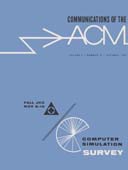October 1966 - Vol. 9 No. 10

Features
Computer simulation—discussion of the technique and comparison of languages
The purpose of this paper is to present a comparison of some computer simulation languages and of some of the packages by which each is implemented. Some considerations involved in comparing software packages for digital computers are discussed in Part I. The issue is obvious: users of digital computers must choose from available languages or write their own. Substantial costs can occur, particularly in training, implementation and computer time if an inappropriate language is chosen. More and more computer simulation languages are being developed: comparisons and evaluations of existing languages are useful for designers and implementers as well as users.
The second part is devoted to computer simulation and simulation languages. The computational characteristics of simulation are discussed with special attention being paid to a distinction between continuous and discrete change models. Part III presents a detailed comparison of six simulation languages and packages: SIMSCRIPT, CLP, CSL, GASP, GPSS and SOL. The characteristics of each are summarized in a series of tables. The implications of this analysis for designers of languages, for users, and for implementers are developed.
The conclusion of the paper is that the packages now available for computer simulation offer features which none of the more general-purpose packages do and that analysis of strengths and weaknesses of each suggests ways in which both current and future simulation languages and packages can be improved.
Eliminating monotonous mathematics with FORMAC
The FORMAC (FORmula MAnipulation Compiler) programming system provides a powerful tool for performing mathematical analysis. It is an extension of FORTRAN IV which permits the use of the computer to perform the tedious algebraic computations that arise in many different fields. Among the areas in which it has been successfully used are: differentiation of complicated expressions; expansion of truncated power series, solution of simultaneous equations with literal coefficients, nonlinear maximum likelihood estimation, tensor analysis, and generation of the coefficients of equations in Keplerian motion. These types of analysis—which arose in the solution of specific practical problems in physics, engineering, astronomy, statistics and astronautics—are discussed in the paper.
In addition to its usage for specific problem solutions, FORMAC can also be used to automate the analysis phase in certain production programming. Several such applications are presented.
Mathematical experimentation in time-lag modulation
Equations of the form du/dt = g(u(t), u(h(t))) arise in a number of scientific contexts. The authors point out some interesting properties of the solution of u′(t) = -u(t - 1 - k sin &ohgr;t) + sin at. These properties were obtained by means of numerical solution.
A procedure is given for continuously computing and monitoring the step size to be used by a self-starting, pth-order numerical integration method to solve an initial value problem. The procedure uses an estimate of the truncation error to calculate the step size.
The American Standard Code for Information Interchange (ASCII) contains a number of control characters associated with the principle of code extension, that is, with the representation of information which cannot be directly represented by means of the characters in the Code. The manner of use of these characters has not previously been completely described.
This paper presents a set of mutually consistent philosophies regarding code extension applications, and suggests a corollary set of doctrines for the application of the code extension characters. Distinctions are drawn between code extension and such other concepts as “graphic substitution” or “syntactic representation” which are often used to meet similar requirements.
Also covered are certain topics which are not truly concerned with code extension but which are often linked with it in discussion on code applications.
The material in this paper is equally applicable in principle to the (proposed) ISO international 7-bit code for information interchange.
Description of systems used for data transmission
Task Group X3.3.51 is working to develop proposals for standards relating to the performance of systems used for digital data transmission. It has published two tutorial papers which were submitted by the U.S.A. to the International Organization for Standardization. In the first paper—ISO/TC97/SC6(USA-7)30,2 May, 1964—the general area of system performance was discussed. In the second paper, ISO/TC97/SC6 (USA-11)60,3 March, 1965, discussed in some detail were two characteristics of system performance, namely, Transfer Rate of Information Bits (TRIB) and Residual Error Rate.
The present paper, the task group's third tutorial paper, is devoted to “System Description” insofar as that topic relates to system performance. Reported are the results of some 14 discussions that have occurred in about 1 3/4 years (June 1964 through March 1966). Including normal turnover of personnel in the group, some 14 people have been involved in these discussions. At present, the members of the task group are associated with business equipment manufacturers, users groups, and suppliers of communication facilities and services in the proportions 5 to 3 to 1.
Other groups have published papers which discuss system description. In April, 1965, a paper from Italy4 was published in which system description was discussed in relation to line control and communication system techniques. In May, 1965, a paper from France5 was published in which system description was discussed in relation to system performance. These papers have been an interesting source of information to X3.3.5.
While considering system performance, X3.3.5 concluded that system performance standards cannot be developed and used fully without having an organized way of describing the hardware and conditions to which performance applies. While this may not be quite t



